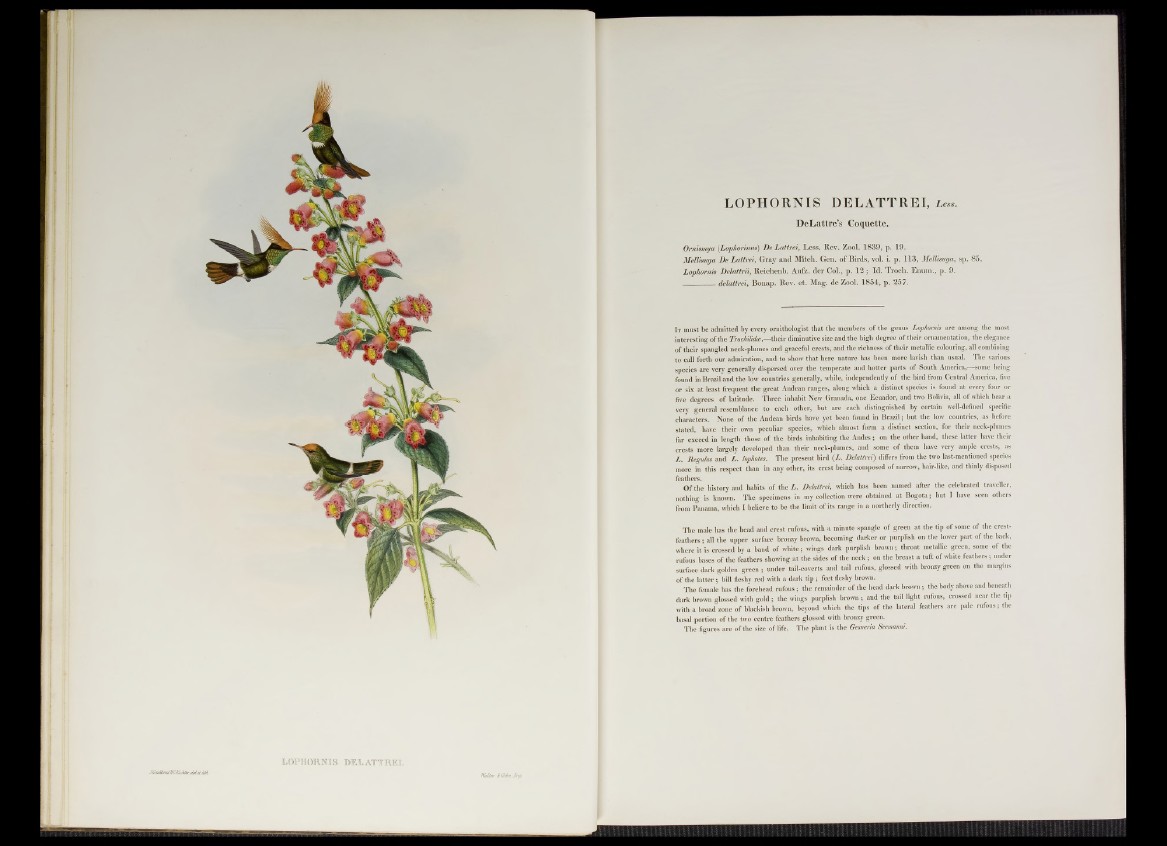
LOPHORNIS DELATTREI.
Waller &GAn./mp
LOPHORNI S DELATTREI, Less.
DeLattre’s Coquette.
Ornismya (.Lophorinus) DeLattrei, Less. Rev. Zool. 1839, p. 19.
Mellimga B e Lattrei, Gray and Mitch. Gen. o f Birds, vol. i. p. 113, Mellisuga, sp. 85.
Lophornis Belattrii, Reichenb. Aufz. der Col., p. 1 2 ; Id. Troch. Enum., p. 9.
_________delattrei, Bonap. Rev. et. Mag. de Zool. 1854, p. 257.
It must be admitted by every ornithologist that the members of the genus Lophornis are among the most
interesting of the Trochilidce,—their diminutive size and the high degree of their ornamentation, the elegance
of their spangled neck-plumes and graceful crests, and the richness of their metallic colouring, all combining
to call forth our admiration, and to show that here nature has been more lavish than usual. The various
species are very generally dispersed over the temperate and hotter parts of South America, some being
found in Brazil and the low countries generally, while, independently of the bird from Central America, five
or six at least frequent the great Andean ranges, along which a distinct species is found at every four or
five degrees of latitude. Three inhabit New Granada, one Ecuador, and two Bolivia, all of which bear a
very general resemblance to each other, but are each distinguished by certain well-defined specific
characters. None of the Andean birds have yet been found in Brazil; but the low countries, as before
stated, have their own peculiar species, which almost form a distinct section, for their neck-plumes
far exceed in length those of the birds inhabiting the Andes; on the other hand, these latter have their
crests more largely developed than their neck-plumes, and some of them have very ample crests, as
L . Reguhis and L . lophotes. The present bird (L. Delattrei) differs from the two last-mentioned species
more in this respect than in any other, its crest being composed of narrow, hair-like, and thinly disposed
feathers.
Of the history and habits of the L. Delattrei, which has been named after the celebrated traveller,
nothing is known. The specimens in my collection were obtained at Bogota; but 1 have seen others
from Panama, which I believe to be the limit of its range in a northerly direction.
The male has the head and crest rufous, with a minute spangle of green at the tip of some of the crest-
feathers; all the upper surface bronzy brown, becoming darker or purplish on the lower part of the back,
where it is crossed by a band of white; wings dark purplish brown; throat metallic green, some of the
rufous bases of the feathers showing at the sides of the neck; on the breast a tuft of white feathers; under
surface dark golden green ; under tail-coverts and tail rufous, glossed with bronzy green on the margins
of the latter ; bill fleshy red with a dark tip ; feet fleshy brown.
The female has the forehead rufous; the remainder of the head dark brown; the body above and beneath
dark brown glossed with gold ; the wings purplish brown ; and the tail light rnfous, crossed near the tip
with a broad zone of blackish brown, beyond which the tips of the lateral feathers are pale rnfous; the
basal portion of the two centre feathers glossed with bronzy green.
The figures are of the size of life. The plant is the Gesncria Seemami.